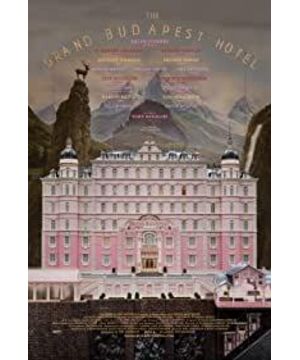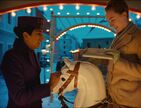Watching "The Grand Budapest Hotel" is like pushing open layers of secret doors into a parallel world of real history carefully built up by the emotions of reminiscence. Through the vocabulary of this world alone, we can see the thrilling resistance and self-struggle of the weak human civilization under the "barbaric slaughterhouse" .
narrative structure
"Symmetry" aesthetics not only appear in the composition, the film also uses a closed loop structure in the narrative . The tombstone, the young writer, the conversation between the young writer and the old Zero, and the memories of Zero, are repeated in reverse after the memory is over, like a precious gift being opened up layer by layer, and it is like a play in a play - every bit of it. After being drawn into the play, it naturally guides the spirit of throwing people into the fantasy world, and subtly realizes the "purifying" effect of "tragedy" that Aristotle called, giving people an excellent and extremely satisfying look and feel.
Narrative rhythm and audiovisual language
The film's unique narrative rhythm and audio-visual skills work together to build this independent world. The ubiquitous sense of rhythm creates unexpected comedic effects, and constitutes dramatic irony with serious themes and serious line content. The movements and expressions of the characters are like stop-motion animation. They enter the fast-forward mode when they are in motion, and they play an extremely prominent role when they are still. If the former brings the overall ease and humor, then the latter creates a small river flowing in the water. The craggy reefs lie dormant in the foreshadowing, and hit it with a single blow at high tide.
Unusual colors such as pink and the overall dreamy tonal atmosphere are spread in a very guiding composition; relaxed and eager, and the music with a certain style of the era follows . These three are unified in the creative impulse and personal style of the director's strong recollection of that particular historical period, which maximizes the illusion of the general's film, and in turn enhances the reality of the set world. . For example: Mr. Gustav took a deep breath and leaned over after a close-up shot of his side face, followed by a brisk and psychedelic music sound, and the main character also walked across the screen with the same rhythm. . This means both Mr. Gustave's entry into his service role and the audience's entry into a specific world constructed by the director.
create character
An important pillar supporting the unique stylized presentation of the film is the character symbolization . The placement of the nickname "Murderer" and the identity of Zero's "door boy" throughout, Mr. Gustave is the embodiment of European classical aristocratic culture. Behind the story of Mr. Gustave and Ozawa's adventure, it shows the survival and reaction of a specific spiritual form in a specific environment - somewhat similar to the concept of "situation" proposed by Mr. Sartre. "The world Gustav maintains has long since passed away, and he relies on his strong personal charm to maintain this illusion as much as possible" is the most obvious expression. The film constructs the character itself through the various reactions and habits of the characters throughout the story, and makes him die with the story.
Going out of the story and looking back at the Grand Budapest Hotel, which has become synonymous with depression, loneliness and persistence, the curtain of the last era of classical aristocratic culture has come down.
mustard
20200404
View more about The Grand Budapest Hotel reviews











